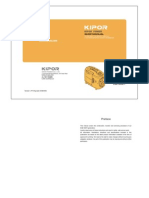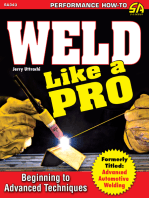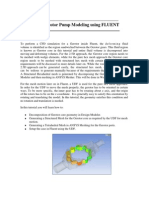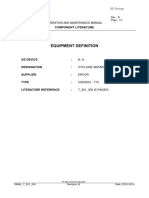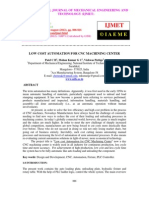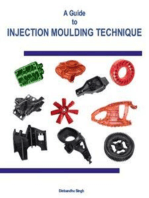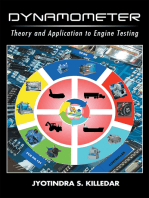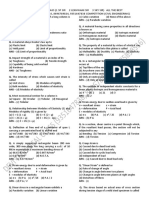Design & Development of Wire Stripping Machine With Adjustable Length
Design & Development of Wire Stripping Machine With Adjustable Length
Uploaded by
omharale5353Copyright:
Available Formats
Design & Development of Wire Stripping Machine With Adjustable Length
Design & Development of Wire Stripping Machine With Adjustable Length
Uploaded by
omharale5353Original Title
Copyright
Available Formats
Share this document
Did you find this document useful?
Is this content inappropriate?
Copyright:
Available Formats
Design & Development of Wire Stripping Machine With Adjustable Length
Design & Development of Wire Stripping Machine With Adjustable Length
Uploaded by
omharale5353Copyright:
Available Formats
e-ISSN: 2582-5208
International Research Journal of Modernization in Engineering Technology and Science
( Peer-Reviewed, Open Access, Fully Refereed International Journal )
Volume:03/Issue:07/July-2021 Impact Factor- 5.354 www.irjmets.com
DESIGN & DEVELOPMENT OF WIRE STRIPPING MACHINE WITH
ADJUSTABLE LENGTH
Prof. Vijay L. Kadlag*1, Mr. Akshay Ajit Ahirrao*2, Mr. Rahul Ramesh Bhor*3, Mr. Harshal
Santosh Muthal*4, Mr. Akash Mhalu Sangle*5
*1Asst. Professor , Department of mechanical Engg, SVIT college of engg, Nashik, Maharastra, India.
*2,3,4,5Student, Department of mechanical Engg, SVIT college of engg, Nashik, Maharastra, India.
ABSTRACT
The automation has become part and parcel of life, it helps in the improvement of daily activities. So it is
decided to automate the processes in the industry with this automation project. In this project, problem
statements selected were in the industry based on the study of different processes and used technology in the
industry. The “Un-Shielding of Multicore Electric Wire up to the Required Length”. In this project, the
focus is on the reduction of time required for insulation removal for further processing. This project is totally
based on pneumatic circuit. This machine works on the single pedal operated by the operator which drives
various valves and actuators and results in the required removal of insulation
Keywords: Wirestripping, Automation, Insulation Removal, Pneumatic.
I. INTRODUCTION
India is a developing country. So to catch up with other developed countries all processes we are dealing with
should be at the optimum level. So that industry should also follow the above rule. Automation is required to
optimise the processes available in the industry. Automation reduces the time required for the process,
increases product quality and reduces the efforts of the worker which results in the higher production rate and
increase in net profit of the company. So the study of various processes used in the company shows that there
are some processes that one can optimise to increase the productivity of the industry.
II. METHODOLOGY
In the initial phase of the project, the processes used in company were thoroughly studied. In this phase, each
and every process from the production line, its importance, process flow chart were studied. From the two
months long study, it was concluded that in the processes studied, some automation is required. The processes
which required automation are as follows :
1.Un-shielding of wire
2.Writing on the wire for identification
3.Ferrule insertion
4.Heating of HST ( Heat Shrinkable Tubing )
5.Insertion of the terminal into the sockets
6.Bundling and picking up wires from stripping machine
7.Potting process
8.Pull force measurement
9. Insertion of uncut and cut conduits in wires
The project proceeds with defining functions and specifications of the un-shielding machine. After that different
ideas are visualized and out of these ideas best idea is selected. Different component required are listed. Basic
pneumatic circuit diagram consisting of all the required functions is drawn. Then the simulation step comes in
the picture where the pneumatic circuit diagram is drawn in the Fluid-SIM software and simulation of this
pneumatic circuit diagram for the required function is cross-checked. Then an experiment is performed in the
industry with the help of Pull Force Measurement Machine for determination of force required to remove the
insulation cover from the multi-core wire. Then standard pneumatic parts are selected with the help of
pressure available and force required for proper operation. Then various features like length measurement and
half cut facility were added and the final design was prepared
www.irjmets.com @International Research Journal of Modernization in Engineering, Technology and Science
[1165]
e-ISSN: 2582-5208
International Research Journal of Modernization in Engineering Technology and Science
( Peer-Reviewed, Open Access, Fully Refereed International Journal )
Volume:03/Issue:07/July-2021 Impact Factor- 5.354 www.irjmets.com
III. MODELING AND ANALYSIS
3.1 Pneumatic Circuit
The industry currently uses the cutter to provide a cut on the insulation of the wire. After that, the worker pulls
the insulation from the wire. This process requires lots of efforts by the operator and hence the process is slow.
To reduce the efforts of the worker and to increase the production rate this process is made semi-automatic.
The wire is unshielded according to the company requirements. The company requires the un-shielding of wire
up to 300mm. The project contains one more feature that if the requirement is to remove the insulation up to
some length as in half cut method then the machine is able to perform the half cut operation also, The
pneumatic un-shielding machine consists of pneumatic components as following.
Figure 1: Pneumatic Circuit
This circuit consists of various pneumatic components. These are as follows:
1) Double Acting Double Ended Rod Cylinders
2) Double Acting Cylinder
3) 5/2 Solenoid valve
4) Flow Control Valve ( Variable orifice )
3.1 Working of Pneumatic Un-shielding Machine:
The system uses compressed air as the source. When the operator operates the pedal, the solenoid valve is
actuated which supplies the air to initial holding cylinder, cutter cylinder and pulling cylinder. These three
double acting cylinders perform their respective strokes but the cutting cylinder and holding cylinder perform
extension stroke and the pulling cylinder perform retraction stroke after completion of extension stroke of
initial two double acting double rod cylinders because of the flow control valve. Due to this wire is held
between holding blocks and cutting blocks produce cut on insulation. The pulling force on cutting cylinder
results into the removal of insulation.
Fig. 2: Actual CAD Model of the Pneumatic Un-Shielding Machine
As soon as the operator releases the pedal or push button, the holding blocks will release the wire and retract
to normal position. And with the extension stroke of the double acting cylinder, the cycle finishes. Different
systems used in the pneumatic un-shielding machine to improve its functionality are as follows:
1) Measuring Rod and Wire Stopper
www.irjmets.com @International Research Journal of Modernization in Engineering, Technology and Science
[1166]
e-ISSN: 2582-5208
International Research Journal of Modernization in Engineering Technology and Science
( Peer-Reviewed, Open Access, Fully Refereed International Journal )
Volume:03/Issue:07/July-2021 Impact Factor- 5.354 www.irjmets.com
2) Pulling Cylinder Stopper
3) Stroke Adjustment and Control
4) Cutting Blade Adjustment
5) Direction Plate
IV. CALCULATIONS
We have assumed, the force required to remove the insulation is 16 kg.
F1 = 16*9.81 = 156.96 N
Total force required to remove the insulation is equal to the sum of F1 and weight of assembly. Weight of
assembly includes weights of cylinders used for cutting of wire, removal of insulation, plate, and cutter blocks.
Weight of assembly = 20 kg.
Total force required to remove the insulation (Tf1) = F1 + 20*9.81
= 156.96 + 196.2
= 353.16 N
Holding force (Hf) = Tf1/μ
Where, μ = Coefficient of friction between wire and holder
= 353.16/0.4 = 882.9 N
Pressure available at company is 6 bars.
Hf = P*(A-a) =6*105*(p/4)* (D2-d2)
Where, P = pressure of air supplied,
A = Area of bore of cylinder,
a = Area of piston rod of cylinder,
D = the bore diameter of cylinder,
d = the piston rod diameter of cylinder.
882.9 =6*105*(p /4)*(D2-d2)
(D2-d2) = 1.8736*10-3 m2
(D2-d2) = 1873.6 mm2
From trial and error method,
502-202 ≥ 1873.6 mm2
Cylinder selected is D = 50 mm, d = 20 mm
Practically from table shown below the cylinder is selected for 882.9N force and 6 bar pressure. Stroke of
cylinder L = 100 mm as per application.
Table 1: Output Force of Double Ended Rod Cylinder
Cylinder Working Pressure in bar
Rod
Bore
Diameter
Diameter 2 3 4 5 6 7 8 9 10
in mm
in mm
Extend 145 217 289 362 434 507 579 651 724
32 12
Retract 124 187 249 311 373 435 498 559 621
Extend 226 339 452 565 678 792 905 1018 1130
40 16
Retract 190 285 380 475 570 665 760 855 950
Extend 353 530 706 884 1060 1237 1414 1590 1767
50 20
Retract 297 445 594 742 891 1039 1187 1336 1484
63 20 Extend 561 842 1122 1403 1683 1964 2244 2525 2805
www.irjmets.com @International Research Journal of Modernization in Engineering, Technology and Science
[1167]
e-ISSN: 2582-5208
International Research Journal of Modernization in Engineering Technology and Science
( Peer-Reviewed, Open Access, Fully Refereed International Journal )
Volume:03/Issue:07/July-2021 Impact Factor- 5.354 www.irjmets.com
Retract 505 757 1009 1261 1514 1766 2018 2270 2523
Extend 561 842 1122 1403 1683 1964 2244 2525 2805
80 25
Retract 816 1225 1633 2041 2449 2857 3266 3674 4082
Extend 1414 2120 2828 3534 4241 4948 5655 6362 7069
100 25
Retract 1325 1988 2650 3313 3976 4640 5300 5965 6625
Diameter of the wire varies from 5 mm to 15 mm and insulation removal length varies from 5mm to 300 mm.
So total force required to remove insulation may vary. Assuming factor of safety 2.5, total force required to
remove insulation can be calculated.
Tf2 = 353.16*2.5 = 882.9 N
Tf2 = P*A = 6*105*(p /4)*(D2-d2)
Where, P = pressure of air supplied,
A = Area of bore of cylinder,
a = Area of piston rod of cylinder,
D = the bore diameter of cylinder,
d = the piston rod diameter of cylinder.
882.9 =6*105*(p /4)*(D2-d2)
(D2-d2) = 1.8736*10-3 m2
(D2-d2) = 1873.6 mm2
From trial and error method,
502-202 ≥ 1873.6 mm2
Cylinder selected is D = 50 mm, d = 20 mm, Practically from table shown below the cylinder is selected for
882.9N force and 6 bar pressure. Stroke of cylinder L = 300 mm as per application.
Table 2: Output Force of Double Acting Cylinder
Cylinder Working Pressure in bar
Rod
Bore
Diameter
Diameter 2 3 4 5 6 7 8 9 10
in mm
in mm
32 12 124 187 249 311 373 435 498 559 621
40 16 190 285 380 475 570 665 760 855 950
50 20 297 445 594 742 891 1039 1187 1336 1484
63 20 505 757 1009 1261 1514 1766 2018 2270 2523
80 25 816 1225 1633 2041 2449 2857 3266 3674 4082
100 25 1325 1988 2650 3313 3976 4640 5300 5965 6625
V. SIMULATION
The pneumatic circuit diagram is drawn in the Fluid-SIM and performed its simulation, analyzed its working.
Solenoid valve is operated by the worker through the pedal. When the worker presses the pedal, air flows into
the cylinders from air compressor and stroke of cylinders takes place. When the worker releases the pedal, air
is released into atmosphere. To reduce noise mufflers are used. The working of pneumatic system is
understood by first and second position of solenoid valve.
First Position of Solenoid Valve:
When solenoid valve is actuated, holding cylinder extends, cutting cylinder extends. Lastly pulling cylinder
retracts due to the setting of flow control valve. This is shown in figure below.
www.irjmets.com @International Research Journal of Modernization in Engineering, Technology and Science
[1168]
e-ISSN: 2582-5208
International Research Journal of Modernization in Engineering Technology and Science
( Peer-Reviewed, Open Access, Fully Refereed International Journal )
Volume:03/Issue:07/July-2021 Impact Factor- 5.354 www.irjmets.com
Fig. 3: Pneumatic Circuit Diagram for First Position of Solenoid Valve in Fluid-SIM
Second Position of Solenoid Valve:
When solenoid valve is de-energized, holding cylinder retracts, cutting cylinder retracts and pulling cylinder
extends. This is shown in figure13.
Fig.4: Pneumatic Circuit Diagram for Second Position of Solenoid Valve in Fluid-SIM
I. MANUFACTURING AND FABRICATION
Table 3: Part and Manufacturing Machines, Processes
www.irjmets.com @International Research Journal of Modernization in Engineering, Technology and Science
[1169]
e-ISSN: 2582-5208
International Research Journal of Modernization in Engineering Technology and Science
( Peer-Reviewed, Open Access, Fully Refereed International Journal )
Volume:03/Issue:07/July-2021 Impact Factor- 5.354 www.irjmets.com
For base plate, intermediate plate material used is Mild Steel, as it is easy to shape and machine. It has good
malleability and weld ability. It has high strength but it is quite soft. For dovetail guide way, material used is
stainless steel, because it is durable and resistant to wear and tear. It is able to withstand high temperatures
without change in its form. It is corrosion resistant. For holding blocks, cutting blocks material used is EN8. It is
medium carbon steel with medium strength. It is readily machinable and has enhanced wear resistant. For
cylinder stopper material used is manganese steel. It is an alloy steel consisting of usually 13% manganese. It is
known for its impact strength and abrasion resistance. For blade material used is D2 Steel, as it has high wear
and abrasion resistant properties. It is corrosion resistant, heat treatable and machinable.
VI. RESULT
it is very essential to calculate all the required forces. To calculate the force required to remove the insulation of
multi core wire, the following experiment is performed .The apparatus used are the pull tester and 2.5*2 core
wire of 7mm diameter, hand wire stripper provided to perform the experiment. 2.5*2 core wire means it has 2
cores of 2.5 mm diameter.
Fig. 5: Experiment performed on Pull Tester
The sample of 2.5*2 core wire of 7mm diameter is taken. A cut on the outer diameter of wire is provided by
hand wire stripper to loosen the insulation. Then the wire is fixed on the pull tester.
After the setting up of wire is done, the pull tester is turned on. Pull Tester applied the load on the wire and the
load at which the insulation is fully removed from wire is noted down.
Fig. 6: Wire before Pull Test
Fig. 7: Wire after Pull Test
From this experiment, the force required to remove the insulation of wire is found to be 16 kg. This force is
easily achievable with our unit. Also stroke length can be varied according to the need.
www.irjmets.com @International Research Journal of Modernization in Engineering, Technology and Science
[1170]
e-ISSN: 2582-5208
International Research Journal of Modernization in Engineering Technology and Science
( Peer-Reviewed, Open Access, Fully Refereed International Journal )
Volume:03/Issue:07/July-2021 Impact Factor- 5.354 www.irjmets.com
VII. CONCLUSION
The motive behind this project is to automate the processes for better productivity. In company , there are
some activities performed by the company consumes a large number of human working hours and ultimately
results in monetary loss to the company. So main focus in designing this project is to keep the time required for
the process as low as possible and the efforts supplied by the worker should be as small as possible. During the
selection of the various parts, the main focus is on the optimization of the cost required for the instrument.
Because of the pneumatic un-shielding machine, the production rate will ultimately increase due to the less
cycle time i.e. 5 seconds. Also cost of machine is very less .Thus the improvements in the above activities will
result in low-cost high-speed production.
FUTURE SCOPE
1) The processes can be automated to more extent by the addition of automatic feeding of wires. The feeding of
the wires with the terminal to the crimp height and crimp width measurement instrument can be automated
to achieve more precise and accurate results.
2) The pneumatic un-shielding machine can be further automated to feed wires automatically and execute
proper un-shielding with the single setting of the machine.
3) The machine is currently open and creating a less safe environment to worker. Hence the machine can be
enclosed in the enclosure to avoid any damage to worker.
4) By implementing ergonomic considerations and guidelines, the machine can be made even more user-
friendly.
VIII. REFERENCES
[1] Pneumatics and Hydraulic Systems, K. Hiraniya Singh, I.K. International Publishing House Pvt. Ltd.
[2] Pneumatic Controls, Joji P., Wiley India Pvt. Ltd.
[3] Pneumatic Systems (Principles and Maintenance), S.R. Majumdar, Tata McGraw Hill Education Private
Limited.
[4] Shingley’s Mechanical Engineering Design, Richard G. Budynas and J. Keith Nisbett, Tata McGraw Hill
Education Private Limited.
[5] Pneumatic Application and Reference Handbook, Bimba Manufacturers.
[6] Pneumatics Practical Guide, Automation DirectI.
[7] G. McLatchey & J. Billingsley, “A review on Control of Pneumatic Cylinder Position”
[8] S. Arunkumar, “Design and fabrication of copper wire stripper and peeling machine”
[9] Manuel Bolotinha, “Cable laying and pulling”
[10] Manjushree Sutar & Bhagyashree Deshmukh, “a review on Design of Linear guide way for higher
accuracy and Precision Motion of machine Tool”
[11] Sufiyan Ahmed Khan, P G Mehar, Dr. A V Vanalkar, Dr. S S Khandare “Calculation of forces and analysis
of stresses in bamboo stripping machine”.
[12] Viktor Szente & János Vad, “Noise and Vibration Studies on Pneumatic Circuit Protection Valves”
[13] Chen Hu, Dasheng Wei, Yanrong Wang & Liang Shi, “Experimental and numerical study of fretting
fatigue in dovetail assembly using a total life prediction model”
www.irjmets.com @International Research Journal of Modernization in Engineering, Technology and Science
[1171]
You might also like
- Performance Exhaust Systems: How to Design, Fabricate, and Install: How to Design, Fabricate, and InstallFrom EverandPerformance Exhaust Systems: How to Design, Fabricate, and Install: How to Design, Fabricate, and Install4/5 (8)
- Design and Analysis of Buried Composite Fiberglass PipelineNo ratings yetDesign and Analysis of Buried Composite Fiberglass Pipeline7 pages
- MWD Failure Report in RUN9 of RZ-08 Well PDFNo ratings yetMWD Failure Report in RUN9 of RZ-08 Well PDF12 pages
- Performance Analysis and Optimization of PDFNo ratings yetPerformance Analysis and Optimization of PDF10 pages
- (IJET-V1I2P4) Authors :mrs - Rita S. Pimpalkar, Rutuja U. Joshi, Rakesh R. Khandare, Rounak R. Agarwal, Bhushan S. BendaleNo ratings yet(IJET-V1I2P4) Authors :mrs - Rita S. Pimpalkar, Rutuja U. Joshi, Rakesh R. Khandare, Rounak R. Agarwal, Bhushan S. Bendale8 pages
- The Design & Calculation For Hydraulic Cylinder of Workpiece Hydraulic Clamping System of A Special CNC Machine For Guide DiscNo ratings yetThe Design & Calculation For Hydraulic Cylinder of Workpiece Hydraulic Clamping System of A Special CNC Machine For Guide Disc5 pages
- Comparision of Beam by Software and Manual Calculation IrjmetsNo ratings yetComparision of Beam by Software and Manual Calculation Irjmets8 pages
- High Precision Linear Slide. Part I: Design and ConstructionNo ratings yetHigh Precision Linear Slide. Part I: Design and Construction13 pages
- Low Cost Automation For CNC Machining Center PDFNo ratings yetLow Cost Automation For CNC Machining Center PDF11 pages
- International Journal of Engineering Research and DevelopmentNo ratings yetInternational Journal of Engineering Research and Development8 pages
- Modular Water Cooled Water Chiller: Shandong Vicot Air Conditioning Co., LTDNo ratings yetModular Water Cooled Water Chiller: Shandong Vicot Air Conditioning Co., LTD15 pages
- Brochure - 14.458 DC Spring Apllied BrakesNo ratings yetBrochure - 14.458 DC Spring Apllied Brakes2 pages
- Grafica de Medidas para Recesion de Valvulas G3400No ratings yetGrafica de Medidas para Recesion de Valvulas G34003 pages
- Performance Analysis of Mixed Flow Pump Impeller Using CFDNo ratings yetPerformance Analysis of Mixed Flow Pump Impeller Using CFD6 pages
- Installation and Operations Manual Ringfeder Elastomer Jaw Couplings TNM G en 07 2023No ratings yetInstallation and Operations Manual Ringfeder Elastomer Jaw Couplings TNM G en 07 202324 pages
- Design-Out Maintenance On Frequent Failure of Motor Ball Bearings-2-3 PDFNo ratings yetDesign-Out Maintenance On Frequent Failure of Motor Ball Bearings-2-3 PDF10 pages
- Design and Fabrication of Intake System For Fsae VehicleNo ratings yetDesign and Fabrication of Intake System For Fsae Vehicle8 pages
- Design and Manufacturing Dual Rate Shock Absorber For All Terrain VehicleNo ratings yetDesign and Manufacturing Dual Rate Shock Absorber For All Terrain Vehicle11 pages
- General:: Name of The Entrepreneur: Mr. Prabhupad BharadwajNo ratings yetGeneral:: Name of The Entrepreneur: Mr. Prabhupad Bharadwaj14 pages
- Development of Semi Automatic Operated Pneumatic Based Wire Stripping MachineNo ratings yetDevelopment of Semi Automatic Operated Pneumatic Based Wire Stripping Machine5 pages
- Static and Thermal Analysis of Piston With Different Thermal CoatingsNo ratings yetStatic and Thermal Analysis of Piston With Different Thermal Coatings13 pages
- Industrial Electric Motors: Installation, Running, Advanced Maintenance and ReliabilityFrom EverandIndustrial Electric Motors: Installation, Running, Advanced Maintenance and ReliabilityNo ratings yet
- Dynamometer: Theory and Application to Engine TestingFrom EverandDynamometer: Theory and Application to Engine TestingNo ratings yet
- Devi Technical Class (1 SP Sir 2 Lekhwani Sir 3 Sky Sir) All The Best CONTACT NO. 9785898516, 8696789024, 9351647838 COMPETITION (CIVIL ENGINEERING)No ratings yetDevi Technical Class (1 SP Sir 2 Lekhwani Sir 3 Sky Sir) All The Best CONTACT NO. 9785898516, 8696789024, 9351647838 COMPETITION (CIVIL ENGINEERING)6 pages
- Solenoid Valve (Proportional Reducing) - Calibrate - Medium Pressure LineNo ratings yetSolenoid Valve (Proportional Reducing) - Calibrate - Medium Pressure Line13 pages
- PFM Portable Hydraulic Testers: User ManualNo ratings yetPFM Portable Hydraulic Testers: User Manual20 pages
- Effect of Wind Speed On Structural Behaviour of Monopole and Self-Support Telecommunication TowersNo ratings yetEffect of Wind Speed On Structural Behaviour of Monopole and Self-Support Telecommunication Towers18 pages
- Influence of Solidification Rate On Material Properties of Cast Aluminium Alloys Based On Al-Si-Cu and Al-Si-MgNo ratings yetInfluence of Solidification Rate On Material Properties of Cast Aluminium Alloys Based On Al-Si-Cu and Al-Si-Mg12 pages
- Abs System and Traction Control System: Section 4ENo ratings yetAbs System and Traction Control System: Section 4E39 pages
- 2012-01-0112method For Identification of The Kiss Point As Well As Takeoff Point of A Hydraulically Actuated Friction Clutch100% (1)2012-01-0112method For Identification of The Kiss Point As Well As Takeoff Point of A Hydraulically Actuated Friction Clutch9 pages
- Scroll Compressor Simulation Model: C. Schein R. RadermacherNo ratings yetScroll Compressor Simulation Model: C. Schein R. Radermacher9 pages
- Weld Like a Pro: Beginning to Advanced TechniquesFrom EverandWeld Like a Pro: Beginning to Advanced Techniques
- Performance Exhaust Systems: How to Design, Fabricate, and Install: How to Design, Fabricate, and InstallFrom EverandPerformance Exhaust Systems: How to Design, Fabricate, and Install: How to Design, Fabricate, and Install
- Design and Analysis of Buried Composite Fiberglass PipelineDesign and Analysis of Buried Composite Fiberglass Pipeline
- (IJET-V1I2P4) Authors :mrs - Rita S. Pimpalkar, Rutuja U. Joshi, Rakesh R. Khandare, Rounak R. Agarwal, Bhushan S. Bendale(IJET-V1I2P4) Authors :mrs - Rita S. Pimpalkar, Rutuja U. Joshi, Rakesh R. Khandare, Rounak R. Agarwal, Bhushan S. Bendale
- The Design & Calculation For Hydraulic Cylinder of Workpiece Hydraulic Clamping System of A Special CNC Machine For Guide DiscThe Design & Calculation For Hydraulic Cylinder of Workpiece Hydraulic Clamping System of A Special CNC Machine For Guide Disc
- Comparision of Beam by Software and Manual Calculation IrjmetsComparision of Beam by Software and Manual Calculation Irjmets
- High Precision Linear Slide. Part I: Design and ConstructionHigh Precision Linear Slide. Part I: Design and Construction
- International Journal of Engineering Research and DevelopmentInternational Journal of Engineering Research and Development
- Modular Water Cooled Water Chiller: Shandong Vicot Air Conditioning Co., LTDModular Water Cooled Water Chiller: Shandong Vicot Air Conditioning Co., LTD
- Grafica de Medidas para Recesion de Valvulas G3400Grafica de Medidas para Recesion de Valvulas G3400
- Performance Analysis of Mixed Flow Pump Impeller Using CFDPerformance Analysis of Mixed Flow Pump Impeller Using CFD
- Installation and Operations Manual Ringfeder Elastomer Jaw Couplings TNM G en 07 2023Installation and Operations Manual Ringfeder Elastomer Jaw Couplings TNM G en 07 2023
- Design-Out Maintenance On Frequent Failure of Motor Ball Bearings-2-3 PDFDesign-Out Maintenance On Frequent Failure of Motor Ball Bearings-2-3 PDF
- Design and Fabrication of Intake System For Fsae VehicleDesign and Fabrication of Intake System For Fsae Vehicle
- Design and Manufacturing Dual Rate Shock Absorber For All Terrain VehicleDesign and Manufacturing Dual Rate Shock Absorber For All Terrain Vehicle
- General:: Name of The Entrepreneur: Mr. Prabhupad BharadwajGeneral:: Name of The Entrepreneur: Mr. Prabhupad Bharadwaj
- Development of Semi Automatic Operated Pneumatic Based Wire Stripping MachineDevelopment of Semi Automatic Operated Pneumatic Based Wire Stripping Machine
- Static and Thermal Analysis of Piston With Different Thermal CoatingsStatic and Thermal Analysis of Piston With Different Thermal Coatings
- Uses of ASME Boiler & Pressure Vessels CodesFrom EverandUses of ASME Boiler & Pressure Vessels Codes
- Industrial Electric Motors: Installation, Running, Advanced Maintenance and ReliabilityFrom EverandIndustrial Electric Motors: Installation, Running, Advanced Maintenance and Reliability
- Dynamometer: Theory and Application to Engine TestingFrom EverandDynamometer: Theory and Application to Engine Testing
- Devi Technical Class (1 SP Sir 2 Lekhwani Sir 3 Sky Sir) All The Best CONTACT NO. 9785898516, 8696789024, 9351647838 COMPETITION (CIVIL ENGINEERING)Devi Technical Class (1 SP Sir 2 Lekhwani Sir 3 Sky Sir) All The Best CONTACT NO. 9785898516, 8696789024, 9351647838 COMPETITION (CIVIL ENGINEERING)
- Solenoid Valve (Proportional Reducing) - Calibrate - Medium Pressure LineSolenoid Valve (Proportional Reducing) - Calibrate - Medium Pressure Line
- Effect of Wind Speed On Structural Behaviour of Monopole and Self-Support Telecommunication TowersEffect of Wind Speed On Structural Behaviour of Monopole and Self-Support Telecommunication Towers
- Influence of Solidification Rate On Material Properties of Cast Aluminium Alloys Based On Al-Si-Cu and Al-Si-MgInfluence of Solidification Rate On Material Properties of Cast Aluminium Alloys Based On Al-Si-Cu and Al-Si-Mg
- Abs System and Traction Control System: Section 4EAbs System and Traction Control System: Section 4E
- 2012-01-0112method For Identification of The Kiss Point As Well As Takeoff Point of A Hydraulically Actuated Friction Clutch2012-01-0112method For Identification of The Kiss Point As Well As Takeoff Point of A Hydraulically Actuated Friction Clutch
- Scroll Compressor Simulation Model: C. Schein R. RadermacherScroll Compressor Simulation Model: C. Schein R. Radermacher

